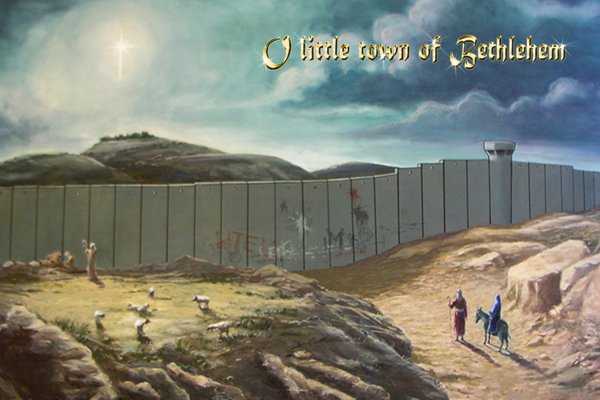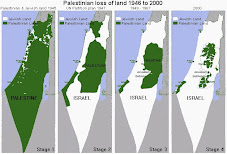 Palestinians walk in fenced lanes beside the 30-foot-high Israeli wall at the entrance to Bethlehem (CNS)
Palestinians walk in fenced lanes beside the 30-foot-high Israeli wall at the entrance to Bethlehem (CNS)Catholic Online - Elizabeth Griffin
Just over 2,000 years ago, the Holy Family made their way from Nazareth to Bethlehem to prepare for the moment that would change history forever. If they were to take that same route today, however, they would be greeted by a 25-foot barrier wall, armed guards and a huge steel gate resembling those found on nuclear shelters.
On a recent journey to the Holy Land as representatives of Catholic Relief Services (CRS), we witnessed this reality and the unfathomable results it has wrought. Before this trip, the full picture of this crisis was not clear to us. What we hear and read in the U.S. media is too filtered for us to really know the whole truth or to know how much the Palestinians in Bethlehem – and throughout the West Bank and Gaza – are suffering.
Some Israel-based human rights groups agree. The Israeli Information Center for Human Rights in the Occupied Territories, which comprises prominent Israeli academics, attorneys, journalists and Israeli parliament members, says, "In areas where the barrier has already been built, the extensive violations of human rights of Palestinians living nearby are evident."
In November of 2005, the birthplace of Christ was sealed off from Jerusalem – just in time for Christmas – depriving people of freedom of movement within their land, annexing entire communities and crippling the local economy.
Amid security procedures locals say are growing more and more invasive, tourists and religious pilgrims, who are the major contributors to Bethlehem's economy, have stayed away in ever-increasing numbers. Those who do visit are encouraged by Israeli-led tour groups not to stay in Bethlehem. Rather, they are encouraged to support the hotels on the outskirts of the city, on the other side of the barrier wall.
Faced with constant and ever-changing restrictions on their movement by Israeli Defense Forces, residents of Bethlehem are finding it harder and harder to get to nearby cities like Jerusalem to work. The movement of goods and merchandise in and out of the walled-in area is completely controlled and taxed by Israeli authorities. All of these factors are contributing to an increasing unemployment rate, which the Bethlehem municipality says now stands at about 65 percent.
Two millennia after the birth of Christ, this ancient, holy city is quite literally being strangled in the shadow of the barrier wall.
If it continues on its present course, the wall will eventually grow to 439 miles in length – more than four times the length of the Berlin Wall – standing as high as 26 feet in some places. Consisting of hundreds of miles of barbed wire and thousands of tons of concrete, it is the largest infrastructure project in Israel, with a price tag to match. The United Nations estimates that the projected cost of the wall will exceed $1 billion – for which the U.S. government is at least partially willing to pay. According to the Applied Research Institute of Jerusalem, a Palestinian nongovernmental organization that tracks the barrier wall's progress, the United States has diverted $50 million from $200 million slated for the Palestinian Authority to construct 34 high-tech, militarily secure crossings in the barrier wall...
........According to the U.N. Office for the Coordination of Humanitarian Affairs, which also closely monitors the progress of the barrier wall, more than 75 percent of the wall's total length is being built inside the West Bank. In July 2004, the International Court of Justice, the principal U.N. judicial organ, ruled that the construction of the barrier wall in Palestinian territory was "contrary to international law."
And a report released in November 2006 by Israeli advocacy group Settlement Watch states that "39 percent of the land used by Jewish settlements in the West Bank is private Palestinian property." According to a Nov. 22 Washington Post article about the report, this land "includes some of the large settlement blocs inside the barrier that Israel is building to separate Israelis from the Palestinian population in the West Bank." Despite all of this, construction continues.
In Bethlehem, the barrier wall has created a prison-like existence for the dwindling Christian population there. The residents are beleaguered, and the merchants we spoke to feel the world does not understand their plight. Others blame fellow Christians overseas for not doing enough on their behalf.
The present-day story of Bethlehem is of a sacred place now enmeshed in concrete and barbed wire, where the humanitarian situation deteriorates and not only compromises human dignity, but also puts at risk the long-term welfare of both Palestinians and Israelis who long for a just peace.
One cannot help but be reminded of the words from the Gospel of Luke: "Let us go now to Bethlehem and see this thing that has happened" (2:15).
This Christmas season, the story of a miracle birth in a quiet manger seems impossibly distant from the little town of Bethlehem that we know today. Full story








